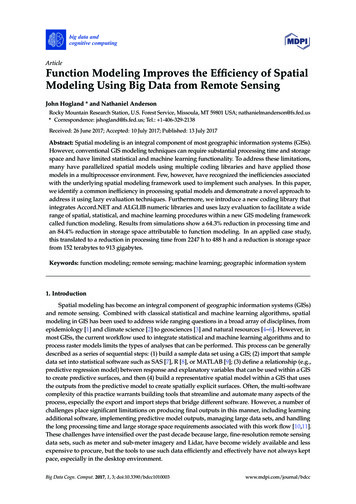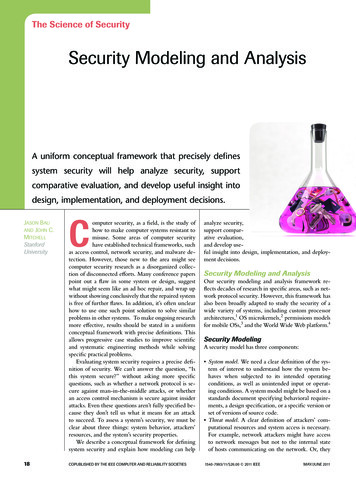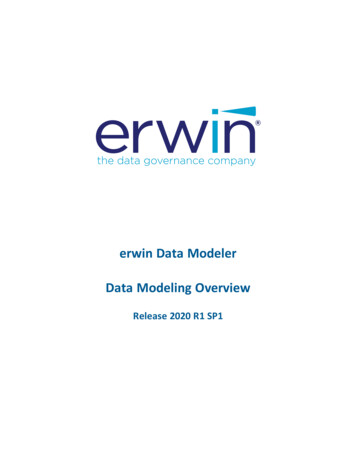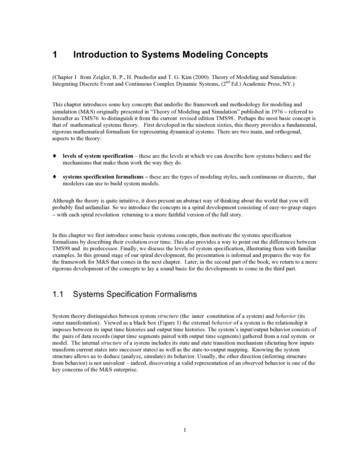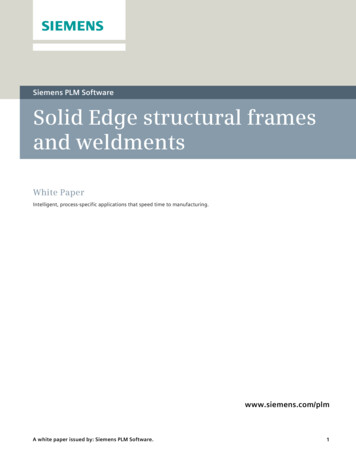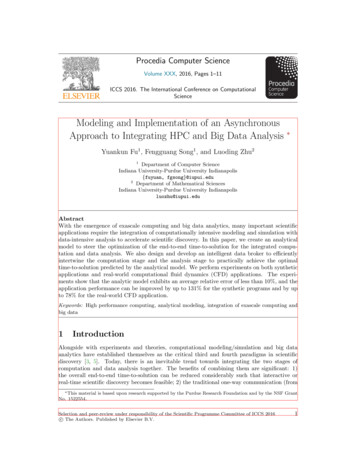
Transcription
Procedia Computer ScienceVolume XXX, 2016, Pages 1–11ICCS 2016. The International Conference on ComputationalScienceModeling and Implementation of an AsynchronousApproach to Integrating HPC and Big Data Analysis Yuankun Fu1 , Fengguang Song1 , and Luoding Zhu21Department of Computer ScienceIndiana University-Purdue University Indianapolis{fuyuan, fgsong}@iupui.edu2Department of Mathematical SciencesIndiana University-Purdue University Indianapolisluozhu@iupui.eduAbstractWith the emergence of exascale computing and big data analytics, many important scientificapplications require the integration of computationally intensive modeling and simulation withdata-intensive analysis to accelerate scientific discovery. In this paper, we create an analyticalmodel to steer the optimization of the end-to-end time-to-solution for the integrated computation and data analysis. We also design and develop an intelligent data broker to efficientlyintertwine the computation stage and the analysis stage to practically achieve the optimaltime-to-solution predicted by the analytical model. We perform experiments on both syntheticapplications and real-world computational fluid dynamics (CFD) applications. The experiments show that the analytic model exhibits an average relative error of less than 10%, and theapplication performance can be improved by up to 131% for the synthetic programs and by upto 78% for the real-world CFD application.Keywords: High performance computing, analytical modeling, integration of exascale computing andbig data1IntroductionAlongside with experiments and theories, computational modeling/simulation and big dataanalytics have established themselves as the critical third and fourth paradigms in scientificdiscovery [3, 5]. Today, there is an inevitable trend towards integrating the two stages ofcomputation and data analysis together. The benefits of combining them are significant: 1)the overall end-to-end time-to-solution can be reduced considerably such that interactive orreal-time scientific discovery becomes feasible; 2) the traditional one-way communication (from This material is based upon research supported by the Purdue Research Foundation and by the NSF GrantNo. 1522554.Selection and peer-review under responsibility of the Scientific Programme Committee of ICCS 2016c The Authors. Published by Elsevier B.V.1
An Asynchronous Approach to Integrating HPC and Big DataY. Fu, F. Song, L. Zhucomputation to analysis) becomes bidirectional to enable guided computational modeling andsimulation; and 3) modeling/simulation and data-intensive analysis are essentially complementary to each other and can be used in a virtuous circle to amplify their collective effect.However, there are many challenges to integrate computation with analysis. For instance,how to minimize the cost to couple computation and analysis, and how to design an effectivesoftware system to enable and facilitate such an integration. In this paper, we focus on buildingan analytical model to estimate the overall execution time of the integrated computation anddata analysis, and designing an intelligent data broker to intertwine the computation stage andthe analysis stage to achieve the optimal time-to-solution predicted by the analytical model.To fully interleave computation with analysis, we propose a fine-grain-block based asynchronous parallel execution model. The execution model utilizes the abstraction of pipelining,which is widely used in computer architectures [11]. In a traditional scientific discovery, a useroften executes the computation, stores the computed results to disks, then reads the computedresults, and finally performs data analysis. From the user’s perspective, the total time-tosolution is the sum of the four execution times. In this paper, we rethink of the problem byusing a novel method of fully asynchronous pipelining. With the asynchronous pipeline method(detailed in Section 2), a user input is divided into fine-grain blocks. Each fine-grain block goesthrough four steps: computation, output, input, and analysis. As shown in Figure 1, our newend-to-end time-to-solution is equal to the maximum of the the computation time, the outputtime, the input time, and the analysis time (i.e., the time of a single step only). Furthermore,we build an analytical model to predict the overall time-to-solution to integrate computationand analysis, which provides developers with an insight into how to efficiently combine them.Output (O)Compute (C)Input (I)Analysis (A)C C C C C CO O O O O OIIIIIIA A A A A AFigure 1: Comparison between the traditional process (upper) and the new fully asynchronous pipelinemethod (lower).Although the analytical model and its performance analysis reveal that the correspondingintegrated execution can result in good performance, there is no software available to supportthe online tight coupling of analysis and computation at run time. To facilitate the asynchronous integration of computation and analysis, we design and develop an I/O middleware,named Intelligent DataBroker, to adaptively prefetch and manage data in both secondary storage and main memory to minimize the I/O cost. This approach is able to support both in-situ(or in memory) data processing and post-processing where initial dataset is preserved for theentire community (e.g., the weather community) for subsequent analysis and verification. Thecomputation and analysis applications are coupled up through the DataBroker. DataBrokerconsists of two parts: a DataBroker producer in the compute node to send data, and a DataBroker consumer in the analysis node to receive data. It has its own runtime system to providedynamic scheduling, pipelining, hierarchical buffering, and prefetching. The paper introducesthe design of the current prototype of DataBroker briefly.We performed experiments on BigRed II (a Cray system) with a Lustre parallel file systemat Indiana University to verify the analytical model and compare the performance of the tra2
An Asynchronous Approach to Integrating HPC and Big DataY. Fu, F. Song, L. Zhuditional process, an improved version of the traditional process with overlapped data writingand computation, and our fully asynchronous pipeline approach. Both synthetic applicationsand real-world computational fluid dynamics (CFD) applications have been implemented withthe prototype of DataBroker. Based on the experiments, the difference between the actualtime-to-solution and the predicted time-to-solution is less than 10%. Furthermore, by usingDataBroker, our fully asynchronous method is able to outperform the improved traditionalmethod by up to 78% for the real-world CFD application.In the rest of the paper, Section 2 introduces the analytical model to estimate the timeto-solution. Section 3 presents the DataBroker middleware to enable an optimized integrationapproach. Section 4 verifies the analytical model and demonstrates the speedup using theintegration approach. Finally, Section 5 presents the related work and Section 6 summarizesthe paper and specifies its future work.2Analytical Modeling2.1The ProblemThis paper targets an important class of scientific discovery applications which require combining extreme-scale computational modeling/simulation with large-scale data analysis. Thescientific discovery consists of computation, result output, result input, and data analysis. Froma user’s perspective, the actual time-to-solution is the end-to-end time from the start of thecomputation to the end of the analysis. While it seems to be a simple problem with onlyfour steps, different methods to execute the four steps can lead to totally different executiontime. For instance, traditional methods execute the four steps sequentially such that the overalltime-to-solution is the sum of the four times.In this section, we study how to unify the four seemingly separated steps into a singleproblem and build an analytical model to analyze and predict how to obtain optimized timeto-solution. The rest of the section models the time-to-solution for three different methods:1) the traditional method, 2) an improved version of the traditional method, and 3) the fullyasynchronous pipeline method.2.2The Traditional MethodFigure 2 illustrates the traditional method, which is the simplest method without optimizations(next subsection will show an optimized version of the traditional method). The traditionalmethod works as follows: the compute processes compute results and write computed resultsto disks, followed by the analysis processes reading results and then analyzing the utInputAnalysisFigure 2: The traditional method.The time-to-solution (t2s) of the traditional method can be expressed as follows:Tt2s Tcomp To Ti Tanaly ,where Tcomp denotes the parallel computation time, To denotes the output time, Ti denotesthe input time, and Tanaly denotes the parallel data analysis time. Although the traditional3
An Asynchronous Approach to Integrating HPC and Big DataY. Fu, F. Song, L. Zhumethod can simplify the software development work, this formula reveals that the traditionalmodel can be as slow as the accumulated time of all the four stages.2.3Improved Version of the Traditional MethodThe traditional method is a strictly sequential workflow. However, it can be improved by usingmulti-threaded I/O libraries, where I/O threads are deployed to write results to disks meanwhilenew results are generated by the compute processes. The other improvement is that the userinput is divided into a number of fine-grain blocks and written to disks asynchronously. Figure3 shows this improved version of the traditional method. We can see that the output stage isnow overlapped with the computation stage so that the output time might be hidden by thecomputation time.{{ComputeProcessAnalysisProcessCompute Compute ComputeOutput Output e 3: An improved version of the traditional method.Suppose a number of P CPU cores are used to compute simulations and a number of QCPU cores are used to analyze results, and the total amount of data generated is D. Given afine-grain block of size B, there are nb DB blocks. Since scalable applications most often havegood load balancing, we assume that each compute core computes nPb blocks and each analysiscore analyzes nQb blocks. The rationale behind the assumption of load balancing is that a hugenumber of fine-grain parallel tasks (e.g., nb P ) will most likely lead to an even workloaddistribution among a relatively small number of cores.Our approach uses the time to compute and analyze individual blocks to estimate the timeto-solution of the improved traditional method. Let tcomp , to , ti , and tanal denote the timeto compute a block, write a block, read a block, and analyze a block, respectively. Then wecan get the parallel computation time Tcomp tcomp nPb , the data output time To to nPb ,the data input time Ti ti nQb , and the parallel analysis time Tanaly tanaly nQb . Thetime-to-solution of the improved version is defined as follows:Tt2s max(Tcomp , To , Ti Tanaly ).The term Ti Tanaly is needed because the analysis process still reads data and then analyzesdata in a sequence. Note that this sequential analysis step can be further parallelized, whichresults in a fully asynchronous pipeline execution model (see the following subsection).2.4The Fully Asynchronous Pipeline MethodThe fully asynchronous pipeline method is designed to completely overlap computation, output,input, and analysis such that the time-to-solution is merely one component, which is eithercomputation, data output, data input, or analysis. Note that the other three components willnot be observable in the end-to-end time-to-solution. As shown in Figure 4, every data blockgoes through four steps: compute, output, input, and analysis. Its corresponding time-tosolution can be expressed as follows:4
An Asynchronous Approach to Integrating HPC and Big DataComputeProcess{AnalysisProcess{Y. Fu, F. Song, L. ZhuCompute Compute ComputeOutputOutputOutputInputInputInputAnalysis Analysis AnalysisFigure 4: The fully asynchronous pipeline method.Tt2s max(Tcomp , To , Ti , Tanaly )nbnbnbnb max(tcomp , to , ti , tanaly ).PPQQThe above analytical model provides an insight into how to achieve an optimal time-tosolution. When tcomp to ti tanaly , the pipeline is able to proceed without any stallsand deliver the best performance possible. On the other hand, the model can be used toallocate and schedule computing resources to different stages appropriately to attain the optimalperformance.3Design of DataBroker for the Fully Asynchronous MethodTo enable the fully asynchronous pipeline model, we design and develop a software prototypecalled Intelligent DataBroker. The interface of the DataBroker prototype is similar to Unix’spipe, which has a writing end and a reading end. For instance, a computation process willcall DataBroker.write(block id, void* data) to output data, while an analysis process will callDataBroker.read(block id) to input data. Although the interface is simple, it has its ownruntime system to provide pipelining, hierarchical buffering, and data prefetching.Figure 5 shows the design of DataBroker. It consists of two components: a DataBrokerproducer component in the compute node to send data, and a DataBroker consumer componentin the analysis node to receive data. The producer component owns a producer ring bufferand one or multiple producer threads to process output in parallel. Each producer threadlooks up the I/O-task queues and uses priority-based scheduling algorithms to transfer data todestinations in a streaming manner. A computational process may send data to an analysisprocess via two possible paths: message passing by the network, or file I/O by the parallel filesystem. Depending on the execution environment, it is possible that both paths are availableand used to speed up the data transmission time.The DataBroker consumer is co-located with an analysis process on the analysis node. Theconsumer component will receive data from the computation processes, buffer data, and prefetchand prepare data for the analysis application. It consists of a consumer ring buffer and oneor multiple prefetching threads. The prefetching threads are responsible for making sure thereare always data blocks available in memory by loading blocks from disks to memory. Since weassume a streaming-based data analysis, the prefetching method can use the technique of readahead to prefetch data efficiently.5
An Asynchronous Approach to Integrating HPC and Big DataY. Fu, F. Song, L. ZhuIntelligent DataBrokerComputationAnalysisGen0 Gen1Producer 0Prefetcher 0Data Data01Producer 1.Prefetcher 1.Prefetcher MData Data23Producer NProducer Ring BufferWriting blocksGen2 Gen3Small file mergeBlock GeneratorData compressionMemoryConsumerConsumer Ring BufferPrefetching blocksMemoryCompute NodeAnalysis NodeParallel File SystemFigure 5: Architecture of the DataBroker middleware for coupling computation with analysis in astreaming pipeline manner. DataBroker consists of a producer component on a compute node, and aconsumer component on an analysis node.4Experimental ResultsWe perform experiments to verify the accuracy of the analytical model and to evaluate theperformance of the fully asynchronous pipeline method, respectively. For each experiment, wecollect performance data from two different programs: 1) a synthetic application, and 2) a realworld computational fluid dynamics (CFD) application. All the experiments are carried out onBigRed II (a Cray XE6/XK7 system) configured with the Lustre 2.1.6 distributed parallel filesystem at Indiana University. Every compute node on BigRed II has two AMD Opteron 16-coreAbu Dhabi CPUs and 64 GB of memory, and is connected to the file system via 56-Gb FDRInfiniBand which is also connected to the DataDirect Network SFA12K storage controllers.4.1Synthetic and Real-World ApplicationsThe synthetic application consists of a computation stage and an analysis stage. To do theexperiments, we use 32 compute nodes to execute the computation stage, and use two different numbers of analysis nodes (i.e., 2 analysis nodes and 32 analysis nodes) to execute theanalysis stage, respectively. We launch one process per node. Each computation process randomly generates a total amount of 1GB data (chopped to small blocks) and writes the data tothe DataBroker producer. Essentially the computation processes only generate data, but notperform any computation. At the same time, each analysis process reads data from its localDataBroker consumer and computes the sum of the square root of the received data block fora number of iterations. The mapping between computation processes and analysis processesis static. For instance, if there are 32 computation processes and 2 analysis processes, eachanalysis process will process data from a half of the computation processes.Our real-world CFD application, provided by the Mathematics Department at IUPUI [15],6
An Asynchronous Approach to Integrating HPC and Big DataY. Fu, F. Song, L. Zhucomputes the 3D simulations of flow slid of viscous incompressible fluid flow at 3D hydrophobicmicrochannel walls using the lattice Boltzmann method [8, 10]. This application is writtenin ANSI C and MPI. We replaced all the file write functions in the CFD application by ourDataBroker API. The CFD simulation is coupled with an data analysis stage, which computesa series of statistical analysis functions at each fluid region for every time step of the simulation.Our experiment takes as input a 3D grid of 512 512 256, which is distributed to differentcomputation processes. Similar to the synthetic experiments, we also run 32 computationprocesses on 32 compute nodes while running different numbers of analysis processes. For eachexperiment, we execute it four times and display their average in our experimental results.4.2Accuracy of the Analytical ModelWe experiment with both the synthetic application and the CFD application to verify theanalytical model. Our experiments measure the end-to-end time-to-solution on different blocksizes ranging from 128KB to 8MB. The experiments are designed to compare the time-tosolution estimated by the analytical model with the actual time-to-solution to show the model’saccuracy.Figure 6 (a) shows the actual time and the predicted time of the synthetic application using32 compute nodes and 2 analysis nodes. For all different block sizes, the analysis stage isthe largest bottleneck among the four stages (i.e., computation, output, input, and analysis).Hence, the time-to-solution is essentially equal to the analysis time. Also, the relative errorbetween the predicted and the actual execution time is from 1.1% to 12.2%, and on average3.9%. Figure 6 (b) shows the actual time and the predicted time for the CFD application.Different from the synthetic application, its time-to-solution is initially dominated by the inputtime when the block size is 128KB, then it becomes dominated by the analysis time from 256KBto 8MB. The relative error of the analytical model is between 4.7% and 18.1%, and on average9.6%.The relative error is greater than zero because our analytical model ignores the pipelinestartup and drainage time, and there is also a small amount of pipeline idle time and jitter timeduring the real execution. Please note that each analysis process has to process the computedresults from 16 computation processes.Actual timePredicted time250200Analysis time dominates15010050160Average time-to-solution (s)Average time-to-solution (s)300Actual timePredicted time140120100Analysis timedominates8060402000128256512 1024 2048 4096 8192Block size (KB)(a) Synthetic experiments128256512 1024 2048 4096 8192Block size (KB)(b) CFD applicationFigure 6: Accuracy of the analytical model for the fully asynchronous pipeline execution with 32compute nodes and 2 analysis nodes.7
An Asynchronous Approach to Integrating HPC and Big DataY. Fu, F. Song, L. ZhuFigure 7 (a) shows the performance of the synthetic application that uses 32 compute nodesand 32 analysis nodes. When the block size is equal to 128KB, the input time dominates thetime-to-solution. When the block size is greater than 128KB, the data analysis time startsto dominate the time-to-solution. The turning point in the figure also verifies the bottleneckswitch (from the input stage to the analysis stage). The predicted time and the actual timeare very close to each other and have an average relative error of 9.1%. Similarly, Figure 7 (b)shows an relative error of 0.9% for the CFD application that also uses 32 compute nodes and32 analysis nodes.Actual timePredicted time40302010Analysis time dominates060Average time-to-solution (s)Average time-to-solution (s)50Actual timePredicted time5040Computation time dominates3020100128256512 1024 2048 4096 8192Block size(KB)(a) Synthetic experiments128256512 1024 2048 4096 8192Block size (KB)(b) CFD applicationFigure 7: Accuracy of the analytical model for the fully asynchronous pipeline execution with 32compute nodes and 32 analysis nodes.4.3Performance SpeedupBesides testing the analytical model, we also conduct experiments to evaluate the performanceimprovement by using the fully asynchronous pipeline method. The experiments compare threedifferent approaches (i.e., three implementations) to executing the integrated computation andanalysis: 1) the traditional method, 2) the improved version of the traditional method whichbuilds upon fine-grain blocks and overlaps computation with data output, and 3) the fullyasynchronous pipeline method based on DataBroker. Each of the three implementations takesthe same input size and is compared with each other in terms of wall clock time.Figure 8 (a) and (b) show the speedup of the synthetic application and the real-worldCFD application, respectively. Note that the baseline program is the traditional method (i.e.,speedup 1). The data in subfigure (a) shows that the improved version of the traditionalmethod can be up to 18 times faster than the traditional method when the block size is equalto 8MB. It seems to be surprising, but by looking into the collected performance data, wediscover that reading two 16GB files by two MPI process simultaneously is 59 times slowerthan reading a collection of small 8MB files by the same two MPI processes. This might bebecause two 16GB files are allocated to the same storage device, while a number of 8MB filesare distributed to multiple storage devices. On the other hand, the fully asynchronous pipelinemethod is faster than the improved traditional method by up to 131% when the block size isequal to 128KB. Figure 8 (b) shows the speedup of the CFD application. We can see that thefully asynchronous method is always faster (up to 56%) than the traditional method whenever8
An Asynchronous Approach to Integrating HPC and Big Data252Improved traditional methodFully asynchronous pipeline method20Y. Fu, F. Song, L. ZhuImproved traditional methodFully asynchronous pipeline methodSpeedup1.5Speedup151010.5500128256512 1024 2048 4096 8192Block size (KB)(a) Synthetic experiments128256512 1024 2048 4096 8192Block size (KB)(b) CFD applicationFigure 8: Performance comparison between the traditional, the improved, and the DataBroker-basedfully asynchronous methods using 32 compute nodes and 2 analysis nodes.the block size is larger than 128KB. The small block size of 128KB does not lead to improvedperformance because writing small files to disks can incur significant file system overhead andcannot reach the maximum network and I/O bandwidth. Also, the fully asynchronous methodis consistently faster than the improved traditional method by 17% to 78%.Figure 9 (a) shows the speedup of the synthetic application that uses 32 compute nodesand 32 analysis nodes. We can see that the fully asynchronous pipeline method is 49% fasterthan the traditional method when the block size is equal to 8MB. It is also 24% faster thanthe improved transitional method when the block size is equal to 4MB. Figure 9 (b) showsthe speedup of the CFD application with 32 compute nodes and 32 analysis nodes. Both thefully asynchronous pipeline method and the improved traditional method are faster than thetraditional method. For instance, they are 31% faster with the block size of 8MB. However, thefully asynchronous pipeline method is almost the same as the improved method when the blocksize is bigger than 128KB. This is because the specific experiment’s computation time dominatesits time-to-solution so that both methods’ time-to-solution is equal to the computation time,which matches our analytical model.5Related WorkTo alleviate the I/O bottleneck, significant efforts have been made to in-situ data processing.GLEAN [13] deploys data staging on analysis nodes of an analysis cluster to support in-situanalysis by using sockets. DataStager [2], I/O Container [6], FlexIO [14], and DataSpaces [7]use RDMA to develop data staging services on a portion of compute nodes to support in-situanalysis. While in-situ processing can totally eliminate the I/O time, real-world applications canbe tight on memory, or have a severe load imbalance between the computational and analysisprocesses (e.g., faster computation has to wait for analysis that scales poorly). Moreover, itdoes not automatically preserve the initial dataset for the entire community for further analysisand verification. Our proposed DataBroker supports both in-situ and post processing. It alsoprovides a unifying approach, which takes into account computation, output, input, and analysisas a whole to optimize the end-to-end time-to-solution.9
An Asynchronous Approach to Integrating HPC and Big Data1.6Improved traditional methodFully asynchronous pipeline method1.41.4Improved traditional methodFully asynchronous pipeline method1.2Speedup1.2SpeedupY. Fu, F. Song, L. Zhu10.80.610.80.60.40.40.20.200128256512 1024 2048 4096 8192Block size (KB)(a) Synthetic experiments128 256 512 1024 2048 4096 8192Block size (KB)(b) CFD applicationFigure 9: Performance comparison between the traditional, the improved, and the DataBroker-basedfully asynchronous methods using 32 compute nodes and 32 analysis nodes.There are efficient parallel I/O libraries and middleware such as MPI-IO [12], ADIOS [1],Nessie [9], and PLFS [4] to enable applications to adapt their I/O to specific file systems.Our data-driven DataBroker is complementary to them and is designed to build upon themto maximize the I/O performance. Depending on where the bottleneck is (e.g., computation,output, input, analysis), DataBroker can perform in-memory analysis or file-system based (outof-core) analysis adaptively, without stalling the computation processes.6Conclusion and Future WorkTo facilitate the convergence of computational modeling/simulation and the big data analysis,we study the problem of integrating computation with analysis in both theoretical and practicalways. First, we use the metric of the time-to-solution of scientific discovery to formulate theintegration problem and propose a fully asynchronous pipeline method to model the execution.Next, we build an analytical model to estimate the overall time to execute the asynchronouscombination of computation and analysis. In addition to the theoretical foundation, we alsodesign and develop an intelligent DataBroker to help fully interleave the computation stage andthe analysis stage.The experimental results show that the analytical model can estimate the time-to-solutionwith an average relative error of less than 10%. By applying the fully asynchronous pipelinemodel to both synthetic and real-world CFD applications, we can increase the performance ofthe improved traditional method by up to 131% for the synthetic application, and up to 78%for the CFD application. Our future work along this line is to utilize the analytical model toappropriately allocate resources (e.g., CPUs) to the computation, I/O, and analysis stages tooptimize the end-to-end time-to-solution by eliminating the most dominant bottleneck.References[1] H. Abbasi, J. Lofstead, F. Zheng, K. Schwan, M. Wolf, and S. Klasky. Extending I/O throughhigh performance data services. In IEEE International Conference on Cluster Computing and10
An Asynchronous Approach to Integrating HPC and Big DataY. Fu, F. Song, L. ZhuWorkshops (CLUSTER’09), pages 1–10. IEEE, 2009.[2] H. Abbasi, M. Wolf, G. Eisenhauer, S. Klasky, K. Schwan, and F. Zheng. Datastager: Scalabledata staging services for petascale applications. Cluster Computing, 13(3):277–290, 2010.[3] G. Aloisioa, S. Fiorea, I. Foster, and D. Williams. Scientific big data analytics challenges at largescale. Proceedings of Big Data and Extreme-scale Computing, 2013.[4] J. Bent, G. Gibson, G. Grider, B. McClelland, P. Nowoczynski, J. Nunez, M. Polte, andM. Wingate. PLFS: A checkpoint filesystem for parallel applications. In Proceedings of the Conference on High Performance Computing Networking, Storage and Analysis (SC’09), page 21. ACM,2009.[5] J. Chen, A. Choudhary, S. Feldman, B. Hendrickson, C. Johnson, R. Mount, V. Sarkar, V. White,and D. Williams. Synergistic challenges in data-intensive science and exascale computing. DOEASCAC Data Subcommittee Report, Department of Energy Office of Science, 2013.[6] J. Dayal, J. Cao, G. Eisenhauer, K. Schwan, M. Wolf, F. Zheng, H. Abbasi, S. Klasky, N. Podhorszki, and J. Lofstead. I/O Containers: Managing the data analytics and visualization pipelinesof high end codes. In Proceedings of the 2013 IEEE 27th International Symposium on Parallel andDistributed Processing Workshops and PhD Forum, IPDPSW ’13, pages 2015–2024, Washington,DC, USA, 2013. IEEE Computer Society.[7] C. Docan, M. Parashar, and S. Klasky. DataSpaces: An interaction and coordination frameworkfor coupled simulation workf
Keywords: High performance computing, analytical modeling, integration of exascale computing and big data 1 Introduction Alongside with experiments and theories, computational modeling/simulation and big data analytics have established themselves as the critical third and fourth paradigms in scienti c discovery [3,5].





